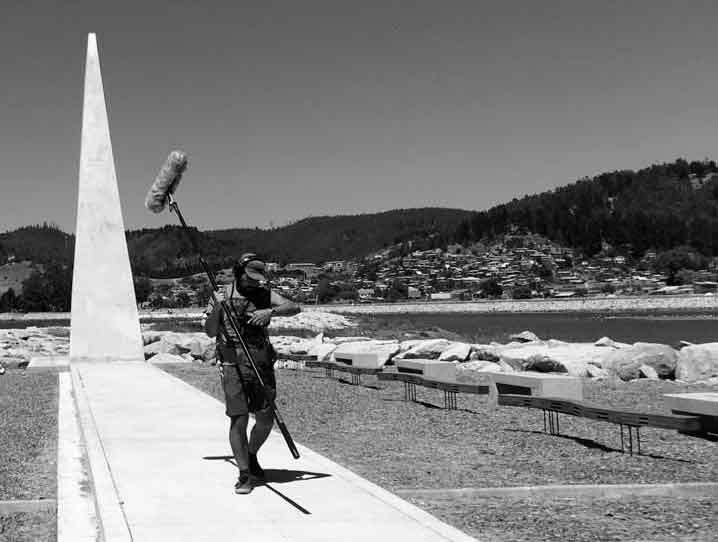The waves of the ocean crashing on the rocks at Pichilemu’s shore, a mesmerizing chorus of cicadas on Buzios, Brazil, or the inside of public transport on Cuzco, Perú. These are all examples of what you may find at audiomapa.org, a collaborative sound cartography for sharing, exploring, investigating and saving the acoustic environment of various corners of the world. Find out this and other related platforms in our latest article. LINK IN BIO.
One of the definitions of traveling is “to visit or go through diverse places or countries by any means of transportation.” When the means of transportation are the senses, especially hearing, traveling turns into an experience that transcends the physical space and takes us to a deep state of contemplation, a pleasant – and many times emotional – connection to the environment. We discover this without even leaving our homes, in front of a computer screen, with headphones and maximum volume, while we browse different platforms of sound cartography created on the Southern Hemisphere of the Earth.
Focusing on Chile and Latin America, this project nowadays offers a repertoire of sound landscapes that expands throughout the American continent, Europe, Asia and Oceania. It is able to do this through a platform which uses Google’s satellite map to locate recordings that any user can share just by logging in and sharing the specific location the register was made.
It is that simple. Plus, audiomapa.org has several listening options that allow the users to reproduce the sounds individually, sorted out by category, author, location or assorted randomly. Basically, it is just like going into Google Maps to look for a restaurant, gas station or museum. All you have to do is click on the headphones displayed on the map and they will reproduce a recording. At the same time, since it is a space of collaboration, you will be able to sign in and upload your own audios placing them on the map.
Explora aquí la plataforma Audiomapa.
This initiative, available since 2012, is a project developed by Chilean sound artist Fernando Godoy and the Festival de Arte Sonoro Tsonami (Tsonami Sound Art Festival). The Festival is one of the most prestigious events of the sound art scene, and takes place in Chile for over a decade, evidencing the sustained growth this discipline has had in South America.
“Without a doubt, there is a growing interest in sound art. It is a matter of measuring it in numbers. There is a lot more people interested, new generations. New artists appear from different worlds: visual arts, music, and merge. There is a growing interest not only from the artists who are a part of it, but also from the audience. People are more receptive to experimental projects and new ways to experience sound. Listening is starting to become valuable. There has been an important change throughout the last 10 or 15 years”, this is what Fernando Godoy tells us in his interview with South Plug.
Evidence of the artistic reach of audiomapa.org is the recent launching or the second compilation of registers uploaded to the platform. It is called “Audiomapa Vol. II |
Océano” (Audiomapa Vol. II | Ocean), and it gathers various recordings of the sea in Latin America, rounding up sound landscapes with the nature of the coast, with no human presence, where the ocean is captured from different perspectives. This work was released reacently, on july the 19th by Tsonami Records, among the activities of La Semana de la Escucha 2020 (The Week of Listening 2020). You can listen to it on this link.

Michel Poblete is one of the sound artists that participates in the latest compilation of audiomapa.org, and tells us one of the main strengths of the platform is “its amplitude regarding the different themes of sound sources. You can find sounds from the ocean, to electromagnetic frequencies. It has more of an artistic component than what you can normally find on the typical sound banks that are used for movies or that sort of productions.”
“Another distinctive element is how simple and practical audiomapa is. For instance, I can be here, and a musician appears playing his music, and I just take my phone, record it and upload it.” Says the sound engineer and sound artist currently dedicated to the sound design of the podcast “Crónica Estéreo” from the “La Tercera” newspaper.

Sound landscaping, as a sub discipline of sound art, is an instantaneous picture of a time and place, from an artistic point of view. However, this kind of sound cartographies also blends with other disciplines such as sound ecology, urbanism and ecosystem monitoring. This is proof that “the study of sound landscape is not something that relates solely to the arts,” Fernando Godoy comments.
“In this sence, Audiomapa is focused in the artistic, but also serves for educational matters” adds the founder of audiomapa.org, who is also the director of the Festival de Arte Sonoro Tsonami, co-editor of the Revista de Arte Sonoro y Cultura Aural magazine, and artistic director of Radio Tsonami, space where work related to sound art are programmed.
Although audiomapa.org was one of the first sound cartographies in the region, over the years this kind of initiatives has skyrocketed in South America. The majority of these cartographies are compiled in the Archivo Usted No Está Aquí (You Are Not Here Archives), a large investigation lead by Georgina Canifrú, sound artist, information manager and Documentary Librarian of the Universidad Metropolitana de Chile.
Archivo Usted No Está Aquí is a project that has been dedicated to investigation and archiving digital documents since 2015. Its focus has been visual and sound art, especially on geographic/cartographic practices and analysis. Thus, in its compilation of “Mapas sonoros de Latinoamérica” (Sound maps of Latin America), it gathers sound cartographies generated by visual and sound artist, along with musicians, anthropologists, scientifics, and different institutions that portray Latin American sound landscapes.
In it we can find sound cartographies that originate on different cities all over South America. For instance, Antropología de lo Cercano (Córdoba, Argentina), Entre Palmeras y Asfalto (Acapulco, México), Mapa Sonoro de Costa Rica, Mapa Sonoro de Uruguay, or the Chilean project AOIR, among many others you can find at Archivo Usted No Está Aquí.
It is evident that sound art and sound landscaping are incipient in our region. If you are interested in exploring another perspective to sound art and experimental music, we invite you to read our article about Alan Licht. If you are attracted towards the work developed by Georgina Canifrú in Archivo Usted No Está Aquí, contact us though our social media so we can check out your project in another article.

